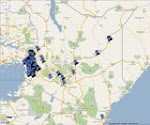Meru GoK Ecosan Project
PROJECT NAME MERU GK PRISON DTS DATE VISITED 16th -17th Sep 2010
PROJECT LOCATION EASTERN PROVINCE-KENYA CONSTRUCTION PERIOD June 2007-May 2008
FUNDING SOURCE EU, GTZ, SIDA, Partners GOK,
Name of Contractor GRANITE CONSTRUCTION CO TIME IN USE From May 2010 after Repairs
CONSULTANT Wakala Moses Contact email Wakala.gtz@gmail.com
Management contact Mr. Charles Mutembei Email mutembeicharles@gmail.com
Meru Water Company Mr Moses Njiiri
mnjiiri@yahoo.com
Objective and Motivation of Project
The objectives of the project were mainly
• Introduce the concept of on-site treatment and utilization of the treated waste in agriculture.
• To boost agricultural production thus increasing food security as a result of treated effluent reuse.
• Improve sanitation in prison
• Reduce the cost of firewood by use of biogas produced during anaerobic treatment.
The main motivation of the project was to increase access to good sanitation to all, as per the millennium development goal number 7.
LOCATION AND CONDITION
Meru GK Prison is a government institution located in eastern province in Meru County and about 220 KM on Nairobi Isiolo road. It has over 1200 inmates and over 300 staff in the 15 hectare compound. The prison is on a sloping ground and is supplied with water from the Meru Water company. The prison management realized the potential of the ecological sanitation through a sensitization from the EPP staff. The prison has a big problem of high firewood consumption for cooking the prisoners’ meals. The prison had also high sewage treatment bills from the treatment plant. These issues combined made the prison management to look into possibilities of adopting new technology from ecosan. Initially all the waste generated from the prison was treated by the municipal sewer. The new technology aimed at treating all the waste in the digester and baffle reactor and reusing the treated effluent in the prison farm as irrigation water and fertilizer. The product of anaerobic decomposition, biogas, also called methane was to be used in the kitchen as source of energy.
Currently as on the date of visit, the digester is being fed by four toilets and the cowshed with two zero-grazed animals. There was no gas production as a result of leakage at the neck seal. This was an opportunity to train the prison officers on the sealing and daily maintenance of the treatment plant. All the treatment components from checking seemed to be working well.
Initially, all the waste from the male prison cells and kitchen was connected to the digester. The digester developed a structural failure and also an over-flow within fewer days than specified in design was noticed. These two reasons led to closure of the entire system and deviation of the main prison waste back to municipal sewer. It has been left like this for almost a half a year. On the visitation day, it was noticed that the service pipes laid earlier connecting the staff toilets and the digester had clogged with surface run-off mad. This must be opened during the re-connection.
It was also realized that one of the water-traps manholes near the kitchen was coved with soil completely and could not be established if it was in a working condition. This is an urgent maintenance duty to be done by the prison officers as the gas was to be used in the kitchen soon after sealing the neck.
Challenges
The main challenge in the project is the excess water flowing non-stop from the cells toilets and kitchen. This water seems to be more than the design parameters and it pushes all the waste out of the treatment plant before the end of the design retention time. With this happening, the quality of the effluent is bad and thus causing pollution to the underground water.
Recommendation
I highly recommend a design to reduce the amount of water from the waste before it is discharged to the digester. This could mean that the shower water and any excess kitchen water can be separated before it flows out for treatment. The grey water and kitchen water could be treated in the aeration ponds in the prison while the rest to undergo anaerobic treatment.
The second water trap near the VIP toilet should be checked and all the soil removed on the cover. It could be important to raise the manhole walls to ensure its accessibility.
The blocked service pipes from staff line should be checked and all mad removed before connection to the digester again.
Meanwhile before other connections, it is better for the system to be tested as it is with 8 staff toilets connected and the cowshed. This will help the prison to establish the output and efficiency of the digester after the previous repairs.
PHOTO DOCUMENTARY
Cowshed with two cows feeding the digester. Baffle Reactor in Meru GoK prison done by Ecosan Promotion Project
Note: All photos in the report are taken by M. Wakala during site visit (Consultant)

























